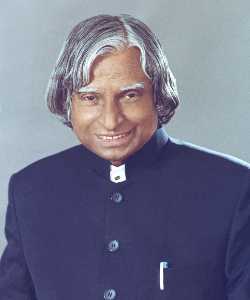| Connecting
over 25 millions NRIs worldwide |
|
|||||||||||||||
|
||
Dr. Avul Pakir Jainulabdeen (A.P.J.) Abdul Kalam was
born on October 15, 1931 in Dhanushkodi, Tamil Nadu. He belongs
to a working class Muslim family. Kalam received his PhD in aeronautical
engineering from the Madras Institute of Technology in 1958. He
joined India's Defense Research and Development Organization (DRDO)
upon graduation to work on a failed hovercraft project. In 1962,
he moved to the Indian Space Research Organization, where his team
successfully launched several satellites. In 1982, he returned to
the DRDO as director, focusing on guided missiles. In 1992, he became
scientific advisor to India's defense minister. On May 11, 1998,
Kalam led India's successful underground nuclear weapon tests. On
July 18, 2002, Kalam was elected by an overwhelming majority (upwards
of 90%) as President.
|
||
| |
| Brief history of the Society The history of science since 1660 is closely intertwined with the story of the Royal Society. The origins of the Royal Society lie in an "invisible college" of natural philosophers who began meeting in the mid-1640s to discuss the ideas of Francis Bacon. Its official foundation date is 28 November 1660, when 12 of them met at Gresham College after a lecture by Christopher Wren, the Gresham Professor of Astronomy, and decided to found ’a Colledge for the Promoting of Physico-Mathematicall Experimentall Learning’. This group included Wren himself, Robert Boyle, John Wilkins, Sir Robert Moray, and William, Viscount Brouncker. The Society was to meet weekly to witness experiments and discuss what we would now call scientific topics. The first Curator of Experiments was Robert Hooke. It was Moray who first told the King, Charles II, of this venture and secured his approval and encouragement. At first apparently nameless, the name The Royal Society first appears in print in 1661, and in the second Royal Charter of 1663 the Society is referred to as ’The Royal Society of London for Improving Natural Knowledge’. The Society found accommodation at Gresham College and rapidly began to acquire a library (the first book was presented in 1661) and a repository or museum of specimens of scientific interest. After the Fire of 1666 it moved for some years to Arundel House, London home of the Dukes of Norfolk. It was not until 1710, under the Presidency of Isaac Newton, that the Society acquired its own home, two houses in Crane Court, off the Strand. |

